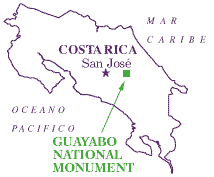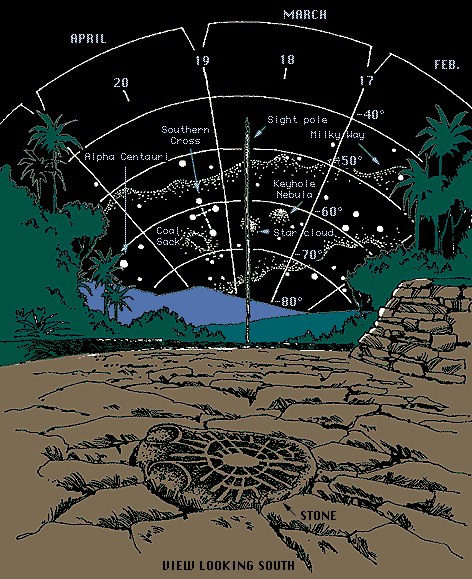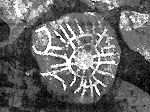Guayabo Sky Map Stone
I had a passive interest in archaeology and
archaeoastronomy, but a strange stone at the Guayabo National Monument
in Costa Rica sparked my interest. --Michael O'Reilly F.
Illustrations
- (Fig.1)
- Conception of the southern sky as it might have looked
to residents of the country's largest pre-Columbian city 500 years ago.
- (Fig.2)
- Photograph of the stone when it was used as a paving
stone in the walkway that surrounds the central mound.
- (Fig.3)
- Modern day map of the region of sky below the -60°
latitude.
- (Fig.4)
- Ancient map of the region of sky below the -60° latitude.
- (Fig.5)
- Part of sky not visible to the observer +10° north
of the equator.
- (Fig.6)
- Rainfall 1979-61
- (Fig.7)
- Green area indicates cloud cover over the mountains.
- (Fig.8)
- The stone displayed with the rectangular coordinate system
showing cloud cover over the southern mountains during May to October.
- (Fig.9)
- How cloud cover builds up during the rainy season obscuring
the sky behind them.
During the late 1970's my family and I lived in a second floor apartment
in Moravia Costa Rica. Moravia is a small and quiet town northeast of San
Jose. A nice thing about this apartment was the small balcony that we shared
with my neighbor on the second floor. From this balcony we had a spectacular
view of the southern sky adorned with a high rim of mountains that mark
the southern boundary of the central valley. Eventually I was able to buy
a used reflector telescope and amateur astronomy quickly became my hobby.
Over the years I came to know the southern sky, partly because the northern
sky was blocked from view on the balcony and partly because the area near
the celestial south pole is full of interesting objects to observe. Not
even the glare from the city lights could obscure the star clouds and with
the help of a telescope, they were splendid. The position of these objects
became burned into my memory after many years of observing this particular
area of the sky.
 Early
in 1975, my family and I decided to pack a picnic lunch and drive up to
the Guayabo National Monument. The park is well known for its natural beauty
and is the largest remnant of the indian civilization in Costa Rica. The
indians who lived here were called Huetares. They lived in this area until
the Spaniards came. The park is deep in the forest about half way up the
southern slope of Turrialba volcano. The ancient indian city is just now
beginning to be uncovered. In 1975 it was estimated that only 3% of the
complex had been uncovered.
Early
in 1975, my family and I decided to pack a picnic lunch and drive up to
the Guayabo National Monument. The park is well known for its natural beauty
and is the largest remnant of the indian civilization in Costa Rica. The
indians who lived here were called Huetares. They lived in this area until
the Spaniards came. The park is deep in the forest about half way up the
southern slope of Turrialba volcano. The ancient indian city is just now
beginning to be uncovered. In 1975 it was estimated that only 3% of the
complex had been uncovered.
The dominant feature of Guayabo National Monument is the central mound which
is a mound buttressed with a round stone wall. In all directions there are
smaller mounds, stone walkways, streets and holding ponds for water. In
all areas of the park you can see stone carvings. These stone carvings are
random lines that wander all over the surface of the rocks. There is one
stone however that is quite different from the rest. In 1975, this 1 1/2
foot diameter stone was located at the south or southeast side of the central
mound imbedded in the stone walkway that surrounds the central mound. On
a trip to Guababo in 1994, I discovered that this area was now closed to
the public and the stone had been removed. A park ranger showed me the stone
that was stored in a trailer on the park grounds. He told me that a mould
was to be made of is so that a copy could be place in the walkway where
the original once rested.

(Fig.1) Conception of the southern sky as it might
have looked to residents of the country's largest pre-Columbian city 500
years ago. The central mound is on the right.
RETURN TO FIG. 5
During this trip, the first time I saw the stone I aimed my camera at
it, focused and decided not to take a picture because it really was not
very impressive and it would be a waste of film. After wandering around
the park I later returned and looked down at the stone again. After a moment
it all came clear and I could not believe what I was seeing. The image of
the southern sky and this stone merged into one image in my head. Naturally
I took a picture, many pictures and that same day worked in my makeshift
darkroom so that I could compare the images with my star maps.
 (Fig. 2)
Photograph of the stone when it was used as a paving stone in the walkway
that surrounds the central mound.
(Fig. 2)
Photograph of the stone when it was used as a paving stone in the walkway
that surrounds the central mound.
Before I reveal what I feel is the startling meaning of this stone, I will
first talk about other things that will make the meaning clearer.
Our galaxy in which we live is a flat disc shaped cloud of stars, we live
on the outer limits of this disc but within the central plain of the galactic
disc. When we look parallel or into this disc in the night sky we see a
multitude of stars, stars so distant but dense that they appear to be a
luminous cloud arching across the sky, this is the milky way. Now if we
were to look away from the plain of the galaxy, the night sky will appear
less populated with stars and darker.
We will now concern ourselves with a small portion of the sky, -90°
(the south pole) to -60° latitude (the southern cross falls along this
-60° latitude). Within this -60° latitude we find many interesting
non stellar objects. From the vantage point of Costa Rica approximately
+10° north of the equator looking due south in December, with a clear
horizon we can see the Large Magellanic cloud. In the October night sky
a little further down on the horizon we can see the Small Magellanic Cloud.
They were both reported and used for navigation by Magellan in 1519. These
two objects are of particular interest because they are the nearest external
aggregation of stars nearest to the Milky Way galaxy. Although the clouds
are considerably smaller than our galaxy and do not exhibit spiral structure,
they are however separate galaxies. Now if we look south in April we will
find the sky quite different because we are looking into the disc of the
galaxy and we see the luminous cloud called the Milky Way but within this
luminous cloud of stars is a dark spot called the Coal Sack. This dark object
lies within the constellation Crux along with the Southern Cross. This dark
spot in the Milky Way is due to a large cloud of obscuring matter that hides
the myriad of stars lying beyond.
If we look at the southern sky in March along the -60° latitude we find
two other interesting objects, a star cloud in the constellation Centaurs
and NCG 3372 or the Keyhole Nebula in Carina.
| NEXT PAGE |
| HOME PAGE Costa Rica In-focus
| TOP OF PAGE |
CONCEPTOS DIGITALES C.R., S.A.
PUBLICIDAD EN INTERNET
All contents copyright © 1999, Conceptos
Digitales C.R., S.A. All rights reserved.
URL: http://www.zurqui.holowww.com/crinfocus/info.html Revised: May 13,
2004
 Early
in 1975, my family and I decided to pack a picnic lunch and drive up to
the Guayabo National Monument. The park is well known for its natural beauty
and is the largest remnant of the indian civilization in Costa Rica. The
indians who lived here were called Huetares. They lived in this area until
the Spaniards came. The park is deep in the forest about half way up the
southern slope of Turrialba volcano. The ancient indian city is just now
beginning to be uncovered. In 1975 it was estimated that only 3% of the
complex had been uncovered.
Early
in 1975, my family and I decided to pack a picnic lunch and drive up to
the Guayabo National Monument. The park is well known for its natural beauty
and is the largest remnant of the indian civilization in Costa Rica. The
indians who lived here were called Huetares. They lived in this area until
the Spaniards came. The park is deep in the forest about half way up the
southern slope of Turrialba volcano. The ancient indian city is just now
beginning to be uncovered. In 1975 it was estimated that only 3% of the
complex had been uncovered.
 (Fig. 2)
Photograph of the stone when it was used as a paving stone in the walkway
that surrounds the central mound.
(Fig. 2)
Photograph of the stone when it was used as a paving stone in the walkway
that surrounds the central mound.